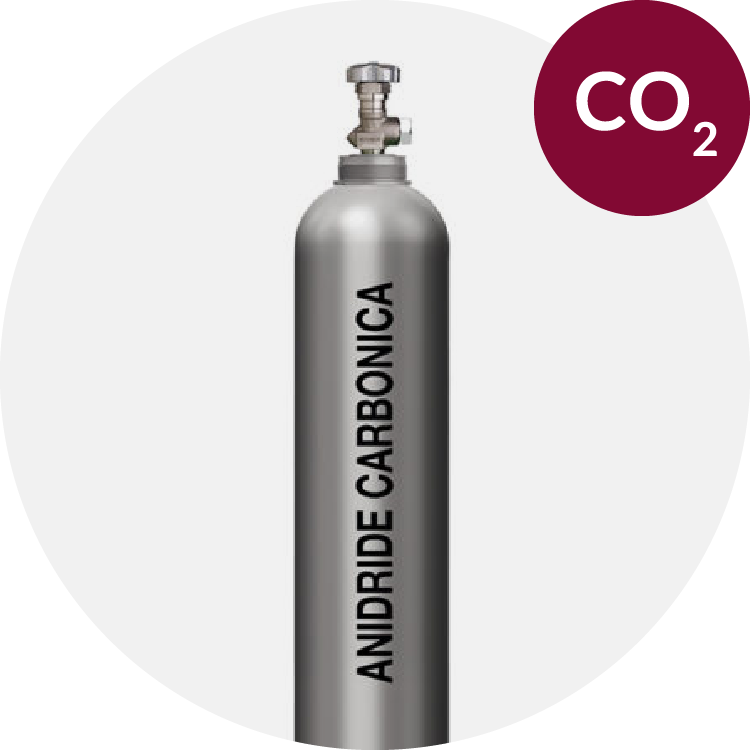
Carbon dioxide is a gas necessary to the cycle of life on our planet since it enables plant growth and, through the process of chlorophyll photosynthesis, the release of oxygen into the atmosphere. CO₂ is absorbed by the leaves and converted into sugars, which are then used to fuel plant growth.
But how is CO₂ used in wine production? In this in-depth discussion, we will focus on the application cases of carbon dioxide in enology and how this gas allows for process efficiency and improved wine quality.
In the winery, carbon dioxide is used at various stages of processing, mainly between grape harvest and fermentation, to remove any oxygen dissolved in the crushing stage, create protective atmospheres and as a coolant. CO₂ has the ability to lower the temperature of grapes and crushed grapes, with different results depending on whether the carbon dioxide is in the liquid or solid state.
Solid-state carbon dioxide is used in the early stages of the wine supply chain to protect the quality of grapes in transport operations from the vineyard to the winery, in grape receiving hoppers, in grape crushing and pressing.
In all of these steps, the creation of protective atmospheres makes it possible to reduce or totally eliminate the presence of oxygen, prevent from oxidation and carry out limited refrigeration.
Companies can alternately employ dry ice or carbonic snow for this purpose. It is always solid CO₂, what changes is the form taken by the product: carbonic snow is the result of the solidification of liquid carbon dioxide while dry ice is obtained from the compression of snow and is available in the form of blocks or pellets.
Here is an in-depth discussion of the two solutions compared.
When the required refrigeration is more important, however, it is good to use CO₂ in its liquid state.
The advantages provided by this solution are different: faster and more complete CO₂ saturation and instantaneous refrigeration can be achieved, with potential up to 400,000 frig/h, without the grape skins suffering thermal shock with cold burns.
For this, at SIAD, we have developed the innovative Kryos® plant for crushed grapes refrigeration, operated by PLC, which operates in an automated manner and efficiently exchanges heat by direct contact between crushed grapes and liquid carbon dioxide.
In many cases, this solution, has allowed a perfect enhancement of the grape varieties and the achievement of a wine of superior quality in several sensory aspects.
Read the case study on liquid CO2 in cryomaceration of crushed grapes at “Il Cascinone” winery
Gaseous CO₂, on the other hand, is a valuable element of wineries during the processing of crushed grapes and must, particularly when stripping action is needed in the pump loading tank or transfer pipe.
In the latter case, The gas, in addition to removing dissolved oxygen and creating protection also plays a lubricating effect resulting in decreased scum formation.
Finally, solid-state CO₂, again in the form of dry ice, is an ally of the entire food and wine supply chain in the cleaning of working environments and machinery.
This process is called cryogenic cleaning or cryopurification (dry ice blasting, in English) and consists of projecting at sonic or supersonic speed small pellets of dry ice at a temperature of -78.5°C onto the surface to be treated, providing flexibility in the use of the raw material and (most importantly) perfect, residue-free cleaning.
Many wineries, around the world and in Italy in particular, are experimenting with the use of food gases in the various steps of the supply chain. In fact, changes in consumer needs and climate change pose several new productivity challenges and the emergence of new needs.
Our Group is acting as an interpreter of these new demands and working side by side with cutting-edge producers who have begun to believe more and more in the use of gases as key players in the winemaking process.
First and foremost, the quality of the CO₂ and its safety are prerequisites. Our carbon dioxide production is through the steam reforming process and is based on the reaction between methane and water vapor at a temperature of 800°C. In addition to the possibility of industrially creating the CO₂, SIAD’s technological innovation also enables the recovery and storage of carbon dioxide, a residue of the manufacturing processes: this allows the economic benefit to be combined with the environmental benefit, thanks to the reduction of greenhouse gases released into the atmosphere that from a waste element becomes raw material for new production.
But that’s not all, thanks to the experience we have gained over the years, our contribution can go far beyond the mere supply of gas. We can design ad hoc plants and offer management consulting, analytical and technical assistance, and organize training sessions.
Learn more about SIAD’s services for enology.
About us
SIAD Group, a century of history in gas production
Among Italy’s leading chemical groups, SIAD is a leader in the production and commercialization of the full range of industrial, specialty, and medicinal gases and related services. The business extends to sectors in synergy with that of gases, including Wine, Food and Beverage.